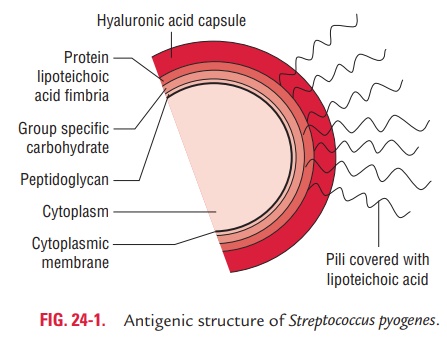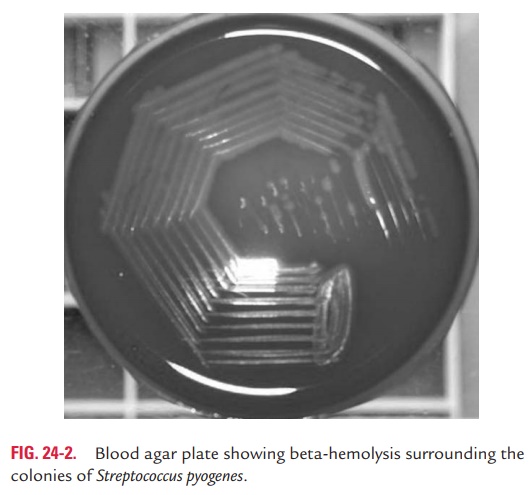Chapter: Microbiology and Immunology: Bacteriology: Streptococcus and Enterococcus
Streptococcus pyogenes
Streptococcus pyogenes
S. pyogenes is the species classified under group A streptococci.It is the most important human pathogen causing:
1. Pyogenic infections, such as bacterial pharyngitis and cellulitis.
2. Toxin-mediated diseases, such as scarlet fever and toxic shock syndrome.
3. Immunologic diseases, such as acute glomerulonephritis (AGN) and rheumatic fever.
Properties of the Bacteria
◗ Morphology
S. pyogenes shows following features:
· They are Gram-positive cocci measuring 0.6–1.0 mm in diameter and are arranged in long chains. Streptococci are nonmotile and nonsporing. Streptococci divide in one plane and thus occur in pairs or in chains of vary-ing lengths, especially in liquid media and clinical specimens.
· They are motile and nonsporing.
· Some strains of S. pyogenes and some strains of group C streptococci produce capsule during the first 2–4 hours of growth. The capsule is composed of hyaluronic acid containing repeating molecules of glucuronic acid and N-acetylglucosamine. It is chemically similar to that of hostconnective tissue and is therefore nonantigenic. Capsu-lated strains produce mucoid colonies on the blood agar (Fig. 24-1).

◗ Culture
S. pyogenes is an aerobe and facultative anaerobe. It grows at 37°Cand at a pH of 7.2–7.4 on enriched medium, such as blood agar.
1. Blood agar: S. pyogenesproduces small white to gray colo-nies, measuring 0.5–1 mm in diameter with a clear zone

of beta-hemolysis (Fig. 24-2, Color Photo 15). Presence of 10% CO2 enhances the growth and hemolysis of colonies. The virulent strains on fresh isolation produce matt colo-nies, while avirulent strains produce glossy colonies. Colo-nies that produce large amounts of hyaluronic acid appear mucoid on the culture plate.
2. Selective media: Crystal violet blood agar is a selectivemedium for culture of S. pyogenes. Addition of 0.0001% crys-tal violet to blood agar makes the medium highly selective for S. pyogenes. This inhibits all other Gram-positive cocci while allowing selective growth of S. pyogenes. PNF medium (horse blood agar containing polymyxin B sulfate, neomy-cin sulfate, and fusidic acid) is another selective medium used for isolation of S. pyogenes.
3. Transport medium: Pikes transport medium containing(1:1,000,000) crystal violet and (1:16,000) sodium azide is a frequently used transport medium for transporting throat swab for culture of S. pyogenes.
4. Liquid medium: S. pyogenesproduces granular turbiditywith powdery deposit when grown in the liquid media, such as serum or glucose broth.
◗ Biochemical reactions
pyogenes shows following biochemical reactions:
· The bacteria are catalase negative; by this property, they are distinguished from staphylococci.
· They ferment many sugars, producing acid but no gas; how-evr, these are of little diagnostic value in the identification of cocci. They do not ferment ribose
· They are not soluble in bile.
· They cause hydrolysis of pyrrolidonyl naphthylamide (PYR).
◗ Other properties
Susceptibility to physical and chemical agents: Streptococciare killed by heating at 54°C for 30 minutes and by usual strengths of disinfectants. They are sensitive to bacitracin. Sensitivity to bacitracin is an important diagnostic feature by which S. pyogenes can be differentiated from other hemolytic streptococci. They are resistant to crystal violet.
Related Topics